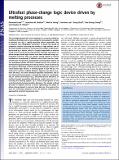Ultrafast phase-change logic device driven by melting processes
Author(s)
Loke, Desmond; Skelton, Jonathan M.; Wang, Wei-Jie; Lee, Tae-Hoon; Zhao, Rong; Chong, Tow-Chong; Elliott, Stephen R.; ... Show more Show less
DownloadLoke-2014-Ultrafast phase-chan.pdf (1.026Mb)
PUBLISHER_POLICY
Publisher Policy
Article is made available in accordance with the publisher's policy and may be subject to US copyright law. Please refer to the publisher's site for terms of use.
Terms of use
Metadata
Show full item recordAbstract
The ultrahigh demand for faster computers is currently tackled by traditional methods such as size scaling (for increasing the number of devices), but this is rapidly becoming almost impossible, due to physical and lithographic limitations. To boost the speed of computers without increasing the number of logic devices, one of the most feasible solutions is to increase the number of operations performed by a device, which is largely impossible to achieve using current silicon-based logic devices. Multiple operations in phase-change–based logic devices have been achieved using crystallization; however, they can achieve mostly speeds of several hundreds of nanoseconds. A difficulty also arises from the trade-off between the speed of crystallization and long-term stability of the amorphous phase. We here instead control the process of melting through premelting disordering effects, while maintaining the superior advantage of phase-change–based logic devices over silicon-based logic devices. A melting speed of just 900 ps was achieved to perform multiple Boolean algebraic operations (e.g., NOR and NOT). Ab initio molecular-dynamics simulations and in situ electrical characterization revealed the origin (i.e., bond buckling of atoms) and kinetics (e.g., discontinuouslike behavior) of melting through premelting disordering, which were key to increasing the melting speeds. By a subtle investigation of the well-characterized phase-transition behavior, this simple method provides an elegant solution to boost significantly the speed of phase-change–based in-memory logic devices, thus paving the way for achieving computers that can perform computations approaching terahertz processing rates.
Date issued
2014-09Department
Massachusetts Institute of Technology. Department of Materials Science and EngineeringJournal
Proceedings of the National Academy of Sciences of the United States of America
Publisher
National Academy of Sciences (U.S.)
Citation
Loke, Desmond, Jonathan M. Skelton, Wei-Jie Wang, Tae-Hoon Lee, Rong Zhao, Tow-Chong Chong, and Stephen R. Elliott. “Ultrafast Phase-Change Logic Device Driven by Melting Processes.” Proceedings of the National Academy of Sciences 111, no. 37 (September 2, 2014): 13272–13277.
Version: Final published version
ISSN
0027-8424
1091-6490